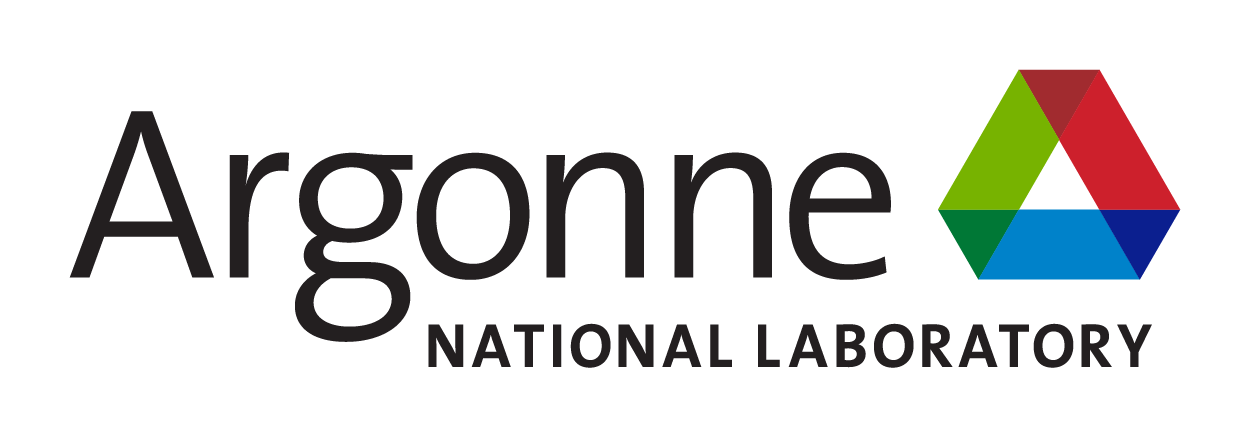USAXS sample holders available
USAXS instrument can accept a variety of relatively large and complex sample holders. The sample-to-analyzer crystal distance can be relatively large without negative influence on the measured data. Therefore it is possible to mount complicated instrumentation in place of the sample. We provide a couple of basic types of sample holders for solids and liquids, as shown below. For other sample holders and apparatus, it is best to contact the instrument scientist.
Solid sample holders
Liquid Sample holders
Heaters and Coolers
Flow cell
************************************************************
Solid samples, powders
For solid samples we most often use Al plate:
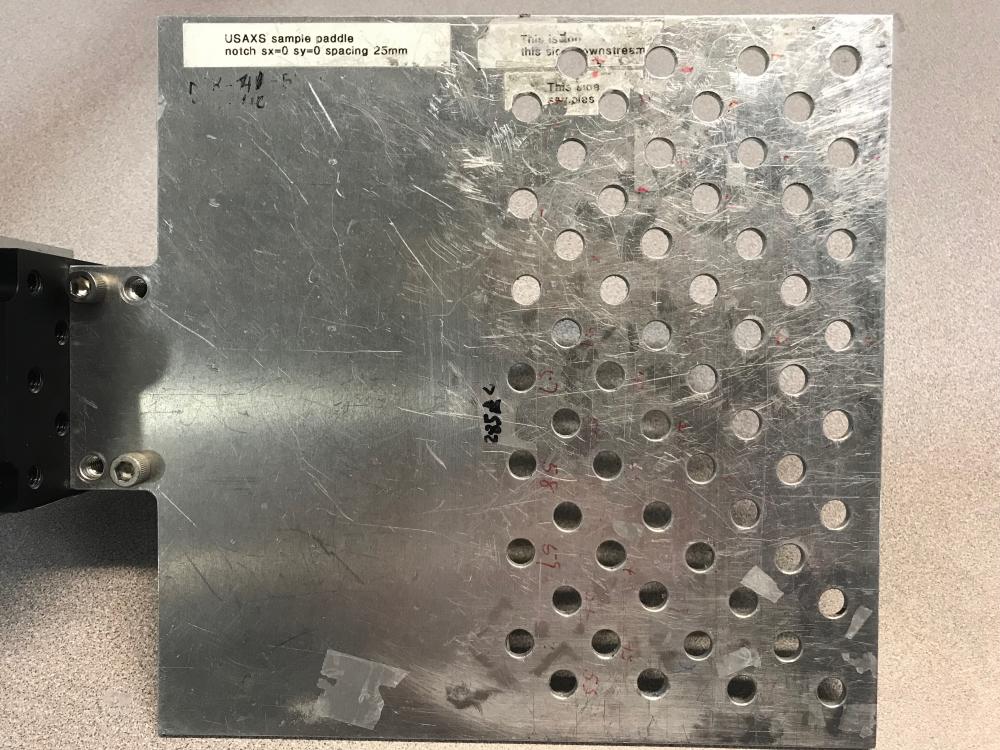
with holes onto which sampels are attached by tape, typically Scotch tape. Scotch tape has been tested and has very little of SAXS and absorption and is therefore one of the best tapes to use. Other tapes are usable, just they may scatter more if they get in the beam.
Magnetic plate :
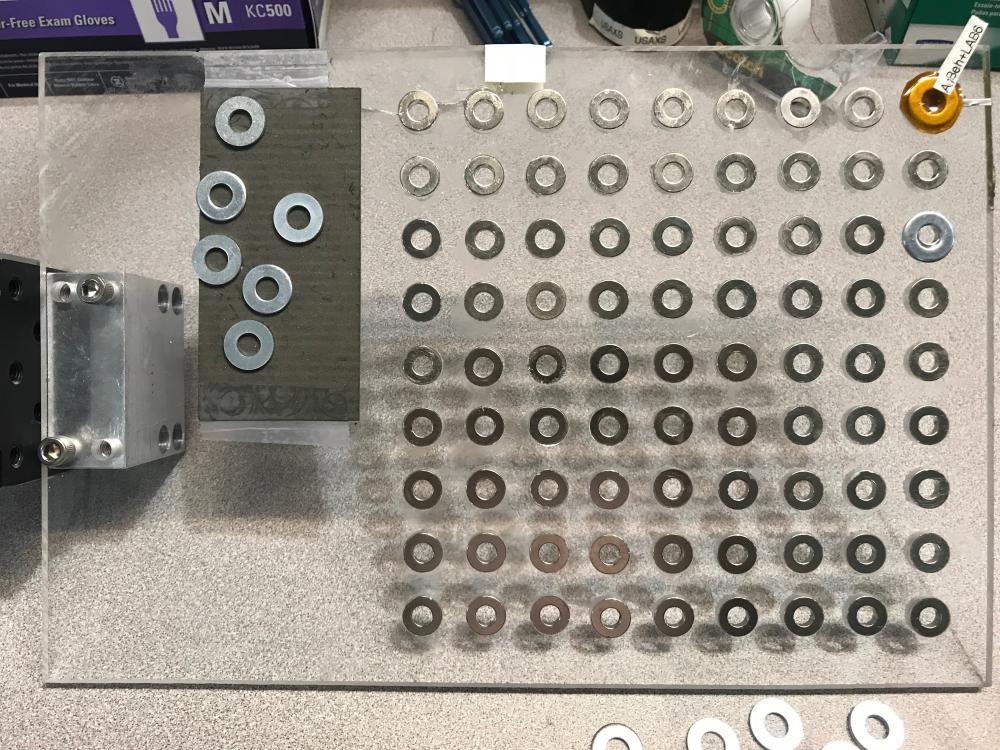
can be used for samples which can be mounted in washers or otehr magnetic material. Not every steel washer is a good magnetic material, the cheaper the better actually. We tested and stock at the beamline these 1/4" x 5/8" OD SAE Type A Narrow Flat Washers, Low carbon steel, ($0.03/pc) washers. Ideal window material is Scotch tape (it has very low SAXS signal), Kapton is usable but keep in mind, Kapton has diffraction peak around 0.3 [1/A]. If samples can be mounted in these washers, they can be quickly attached and removed from this plate at the beamline, making setup efficient. This magnetic plate may be easier to then the Al plate.
Example of samples in washers:
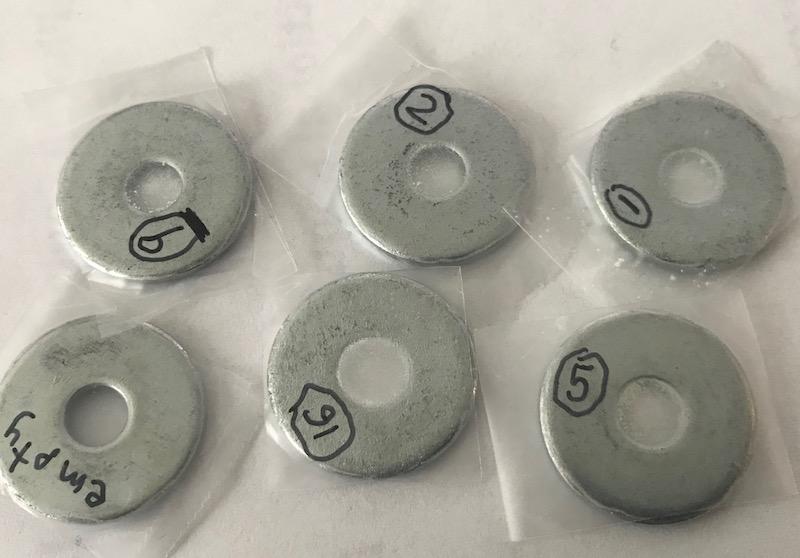
************************************************************
Liquid samples
Flat-plate like holders: Single use liquid sample holders we tested are silicone isulators from Grace bio-labs which can be combined with two ~25micron thick glass microscopy cover slips to create single use liqid containers. We have designed convenient holders for various sizes and designs (JTR20-A2-1.0, JTR13R-A2-1.0 and JTR8R-A2-1.0), all 1mm thick. For special needs there is also sheet material (JTR-SA2-1.0), so custom containers can be made. Due to use of glasscover slips these cells need to be used at X-ray energies above 10 keV. For weakly scattering samples you can use 2mm or even thicker (if available) cells, Grace-bio makes these up to 2.5 mm thickness and the plastic itself can be bought in number of thicknesses in McMaster-Carr (even though the sticky tape needs to be bought separately. At 21-24 keV you can use easily 5mm path through water based samples and get better signal-noise ratio. Alternatively, these cells can be used with kapton sheets as window material. Minimum sample volume of the smallest container is 50 micro litres (8mm diameter opening, 1mm thick). These holders cannot be heated or colled.
Selection of these can be also found in sigmaaldrich.com catalog, search for "Grace Bio-Labs Press-To-Seal", make sure the title has "PSA both sides". Here is example of 25pc of 13mm dia hole with 2.5mm thickness for $95 (7-2016 price).
Note: The cost of these sample holders is quite singificant for us, and due to budget limitations we are unable to provide these sample holders for free. Please, buy your own. June 2014 costs are:
JTR8R-A2-1.0 (#666105), 8 samples/pc, $167 for 25 pcs (1mm, 2mm thick SigmaAldrich).
JTR20R-A2-1.0 (#666104), 1 sample/pc, $116 for 25pcs (1mm, 2mm, 2.5mm thick SigmaAldrich).
JTR13R-A2-1.0 (#666107), 1 sample/pc, $ 96 for 25pcs (1mm, 2mm, 2.5mm thick SigmaAldrich).
Capillaries for liquid samples:
For users with sufficient amount of sample volume capillaries we tested and succesfully used NMR tubes. The NMR capillaries we have used are 4mm internal diameter, 5mm external diameter, with cap included. They provide ~3x better singal-to-noise ratio than 1mm diameter capillaries if transmisison is reasonable. For water/regular light solvent based samples and 18keV or higher X-ray energies these capillaries work fine. One source of these is here: Fisher scientific Wilmad Thin Walled High Throughput NMR tumeb (cat. No. 16-800-161). We hope to have these at the beamline (100 of these costs ~ $100) but I suggest users buy their own to make sure there is enough fo them. We have currently capillary holder which enables us to measure about 12 at a time. These capillaries also enable recovery of the sample after measurements. We have heating block for these capillaries where users can heat the samples to about 150C.
NMR tubes holder:
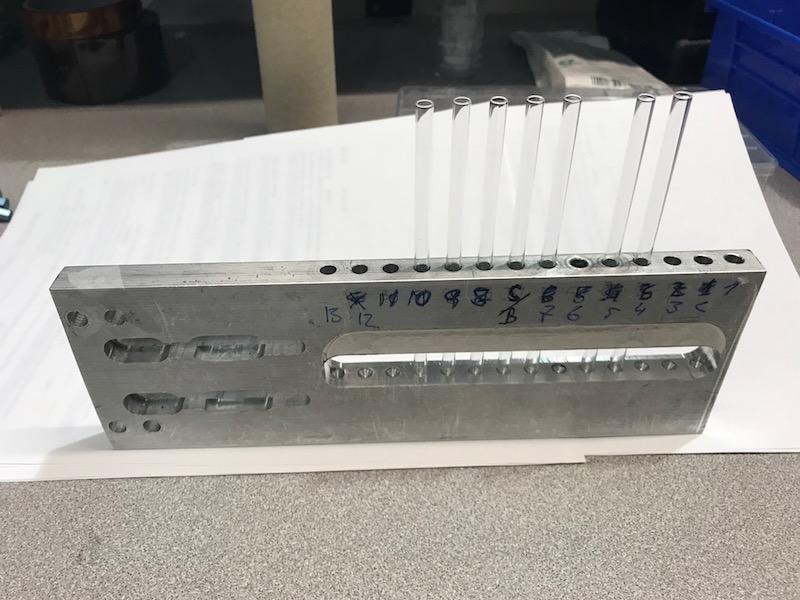
NMR tubes heater. This heater has been tested to over 300C if needed. At around 300C the variation in temperature among the different NMR tube positions is within 5C across the whole length of the heater. Smaller variation is likely among smaller number of NMR tubes on the right hand side in the picture.
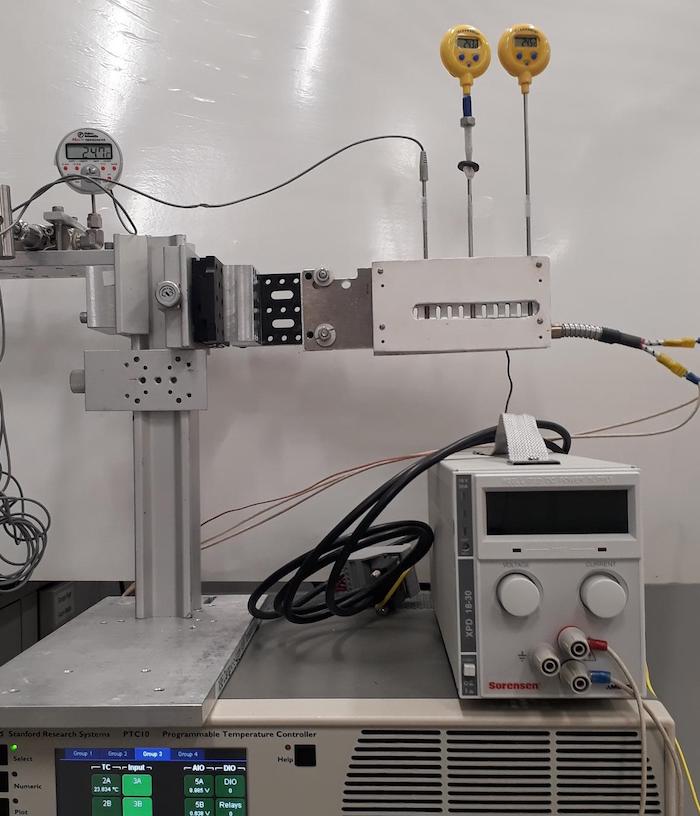
Alternative capillaries we tested are ~1.4mm internal diameter and succesfully use are melting capillaries, much cheaper than dedicated X-ray capillaries and much easier to use - and very good for samples with stronger scattering. One source of these is here: Kimbel Chase KIMAX Melting capillaries. We routinely have these at the beamline (as 100 of these costs ~ $20). Recovery of sample from these is difficult. We have heating block for these capillaries where users can heat samples up to ~85C.
We also can use dedicated X-ray capillaries and our experience suggests, that 1 or 1.5mm capillaries from Charles Supper company are suitable for most needs. Thicker capillaries (2-5mm) are suitable (and better), though they get really expensive. At higher energies (21keV) we could usually measure 5 - 7 mm of water based samples and thicker sample provides better signal-to-noise data (at minor cost of Q resolution). It does not matter if capillaries are glass, borokapilalries, or Quartz. Thinner then 1mm are difficult to use in USAXS due to beam size. Since package of Charles Supper capillaries (25 pcs or less) costs around $130, we are unable to provide these to users. We simply do not have budegt for it. Recovery of sample is unlikely and yes, they break all the time. We have heating block for these capillaries where users can heat samples up to ~85C.
Capillaries holder:
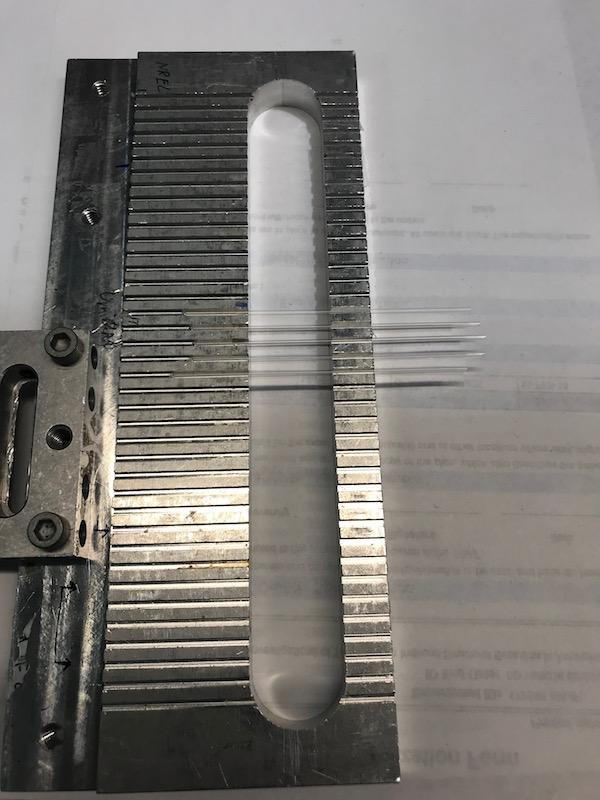
************************************************************
Heaters and coolers
Heating & cooling equipment: We have Linkam THM600 heating and freezing stage or Linkam TS1500 at the beamline available for users use. If you would like to use this stage for your experiment, please, contact instrument scientist during scheduling phase. You need to prepare samples suitable for a specific stage. For details on the stage, please see manufacturer's web site and/or talk to the staff. We routinely stock at the beamline Nitrogen and Artgone inert gasses for protecting atmosphere.
************************************************************
Flow cell experiments
Many users want to use flow cell to measure their liquid samples. This reduces the X-ray damage to the samples and allows users to study changes in the sample as function of time/pH/temperature/... Keep in mind, that filling flow cell is done by hand and is time consuming, Flow cells also need to be cleaned which is not always easy or even possible... We had success with using 4mm internal diameter capillary (the Wilmad NMR tubes) for flow cells and at 21keV they work very well - and they are easy to handle. Users need to provide tubing for their experiments, as it gets contaminated by the samples and needs to be replaced for each user.
Tubing needed to build a flow cell which user needs to provide:
10 feet (3 m) of polytetrafluoroethylene (PTFE) tubing, Source: Fischer Scientific, Part# 0660527 Description: Cole Parmer, Zeus Industrial Products Inc model number 94812, PTFE tubing, 1/16In ID x 1/8In OD, 25 ft/pack
Parts typically provided by beamline, users can procure if they have available funds (check with beamline first)
One foot of thin silicone tubing to connect PTFE tubing to the cell and other connectors, Source: Fischer Scientific, Part# 14179110, Description: Thermo Scientificâ„¢ Nalgeneâ„¢ Pharma-Grade Platinum-Cured Silicone Tubing; 1/8 in (OD), 1/16 in (ID); 50 ft/pack
One foot of thick silicone tubing for the peristaltic pump, Source: Fischer Scientific, Part# 14179114, Description: Thermo Scientificâ„¢ Nalgeneâ„¢ Pharma-Grade Platinum-Cured Silicone Tubing; 3/8 in (OD), 1/4 in (ID); 50 ft/pack
Selected connectors from Cole-Parmer Luer Fitting Kit, Source: Cole-Palmer, Part# EW-45511-00, Description: Cole-Parmer Luer Fitting Kit, Assorted Materials/Sizes, 477 Pieces/Pk
The glass flow cell, cut with a diamond saw from an NMR tube, Source: Fischer Scientific, Part# 16800161, Description: Wilmadâ„¢ Thin Walled High Throughput NMR Tubes; ASTM E438 Type 1 Class B glass; 5mm (OD); 0.43mm (wall thickness); 103.5mm (length); 100 piecesÂ
Two small pieces of 3/16 (ID) latex tubing to connect to the glass tube (available at the APS stockroom, Inside APS link ONLY).
